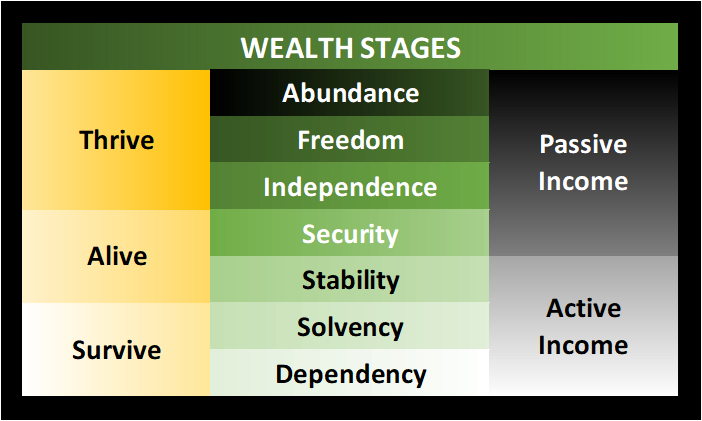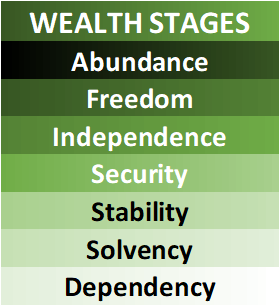
One of the biggest problems I had when I was first starting my personal finance journey was figuring out what were ‘reasonable’ targets. I wanted a more definitive set of targets to strive for that also had a basis in real changes to one’s quality of life, stage of living, wealth position, etc.
I wanted these targets to be…
- comparable to others so that I can compare my progress to friends or mentors
- building to an overall framework that’s fits with my personal finance views and strategy
- relative to my income or income level so that it makes sense no matter how much one makes
- standard and easily calculated such that it only takes simple math
- flexible as my income, living situation, family composition, or other pertinent factors change, my targets could maintain the relevancy
What I came up with were the following 7 stages

I didn’t just pick these out of the blue. They very specifically reflect the progression of moving from active income generation to passive income generation. This progression is also known as moving from “worker” to “investor”. They also very specifically reflect the movement from simply surviving in life, to really being alive and finally to truly thriving.
My end goal is to thrive with abundant wealth generated entirely from passive income.

Wealth Stage Calculation
Below are 5 terms used in calculation of one’s wealth stage. They represent levels of revenues or savings, multiples of which signify moving from one stage to the next. This is what I call my Personal Finance Equations
[RX] Required Expenses = food +shelter + clothing + job expense + min debt payments
[DX] Discretionary Expenses = all other expense – vacation, dining out, charity
[EF] Emergency Fund = cash readily available (<24 hrs)
[AI] Active Income = Income derived from employment
[PI] Passive Income = Income derived from investment without liquidating principal (Net income from real estate after all expenses)
- Dependency = AI < RX + 0EF
- Required Expenses greater than net income
- Emergency fund = 0
- Dependent on others for basic survival needs
- Cash flow negative
- Solvency = AI > RX + 3EF
- Net income equal to Required Expenses
- Emergency fund = covers 3 months (3EF) of Required Expenses (RX)
- Cash flow neutral, but just barely. Only can cover absolute essentials.
- Stability = AI > RX +DX + 6EF
- Total expenses and emergency fund less than net income
- Emergency fund = covers 6 months (6EF) of Required Expenses (RX)
- Cash flow positive
- Security = PI > RX +12EF
- Passive income covers Required Expenses RX
- Emergency fund = covers 12 months (12EF) of Required Expenses (RX)
- Independence = PI > RX + DX + 18EF
- Passive income covers total expenses
- Emergency fund = covers 18 months (18EF) of Required Expenses (RX)
- Freedom = PI > 2RX + 2DX +24EF
- Emergency fund = covers 24 months (24EF) of Required Expenses (RX)
- Debt Free
- Abundance = PI > 3RX + 3DX +36EF
- Wealth assets more than enough to lie on and then some using only passive income
- Emergency fund = covers 36+ months (36EF) of Required Expenses (RX)

What you will notice about these stages:
They are definitive
There is an equation for each stage that clearly identifies what levels of income and savings is required to be considered for each wealth stage. It’s not a judgement call. It isn’t some mushy set of qualifications.
They are flexible based on what you consider as required and optional expenses
The larger a life you “choose” to live, the larger the runway to the next stage. The main component of determining your stage is the amount you spend each day, week, month and year. Notice I used the word choose. There are really, very few truly “required” costs. The distinction between dependency, solvency and stability is an important one for this simple distinction between “required” expenses and total expenses.
They are both specific and relative
Allows me to set specific targets while allowing for the variations and relative differences in peoples incomes, expenses, obligations, goals, situations, etc. Being a millionaire has little relevant distinction to someone who spends $250K per year on clothes, cars, dining out and vacations.
They’re customizable based on each individuals desired standard of living
Required expenses excludes “discretionary” expenses, it could also be referred to as “luxury” expenses. Required expense means vastly different things to different people. From living in your car to a 4 bed 5 bath mansion, to somewhere in between, there is one common factor. There are certain set costs associated with ones living expenses. The first step towards wealth is to at a minimum, cover these costs.
I refuse to live on PB&J sandwiches. But I also don’t need to drink Dom Perignon every Friday night. I’ve set a standard and am very comfortable with it. Setting your standard of living and then knowing what it takes to maintain it is critical to the comfort level you have with your plan.
They evolve based on each individual changing situation over time
These stages will vary over a lifetime as you age and move through the various stages of your life. A twenty-year old’s required expenses are obviously expected to differ from a 45-year old’s. Tracking the fluctuations in these levels allows you to set a baseline. Are you spending too much based on your historic trends on optional expenses? How much have your required expenses risen as you’ve bought a house, had children, attended college or moved to different areas of the country with varying costs of living indexes?
They are judgement free
You decide your individual standard of living and thus what it would take to sustain that level throughout retirement or over a lifetime.
Notes about the calculations
Dividends:
I include what potential dividends would be of my retirement accounts for planning purposes as you build towards independent, freedom and abundance. But for the purposes of early retirement, or FIRE decisions, I would exclude accounts that I can’t access until a later age (401K, IRA, etc.)
Freedom vs Independence:
There isn’t that much difference between these two stages. Then again, there is a very big difference. The concept of complete debt elimination.
Independence: Can have debt, if it is covered by passive income.
Freedom: You have completely removed any debt such as mortgage, car or credit card.
Required Expenses:
There is no coincidence that Rx is the sign for prescription. Because minimizing your expenses as much as possible is the prescription for wealth building. Financially successful people limit costs that are not necessary.
Required vs Discretionary Expenses:
All calculations for Expenses (RX & DX) are kept separate. There is not a TX for total expenses, and this is purposeful. You should never look at your expenses as one single entity, but continuously work to break them into compulsory and elective. The discretionary expenses represent your single easiest path to increased cash flow. Need more money? Eat out less. Buy fewer pocketbooks. Buy less beer.
Emergency Fund:
All calculations of emergency funds are based on RX Required Expenses. This assumes during a real emergency, you will decrease or eliminate DX Discretionary Expenses.
Dependency:
I specifically call it this because this financial position is not sustainable without some help from family, friends, or government. It should be of some note that there are many Americans, who are not minors or college students, but still fall into a dependency category. Your first step must be to escape this stage.
Options:
These stages represent my views and values. You may create your own stages or use modified milestone calculations. For example, calculate Passive Income using readily/immediately available assets (exclude those in retirement funds if less than 59.5 and exclude primary residence). Or convert and include all investible assets. Or calculate your emergency fund needs based of both required and discretionary expenses.
Whether you agree with my wealth stages or my milestone calculations, I believe it’s important to utilize some milestone mechanism on your wealth building journey. As with anything I post, ignore it, adjust it, or use it as is. This is just what I do. What do you do? Post to comments.
Examples






I know this is a lot to digest. And I’ll be talking about it in upcoming posts. It is the structure underpinning my entire financial planning process. That’s how important I think this concept is. Do I have something here? What are your thoughts?

5pj7ex
4tj0op
Awesome https://is.gd/N1ikS2
Good https://is.gd/N1ikS2
Good https://is.gd/N1ikS2
Very good https://is.gd/N1ikS2
93nssa
Very good partnership https://shorturl.fm/68Y8V
Very good partnership https://shorturl.fm/9fnIC
https://shorturl.fm/FIJkD
https://shorturl.fm/m8ueY
https://shorturl.fm/TbTre
https://shorturl.fm/oYjg5
https://shorturl.fm/9fnIC
https://shorturl.fm/YvSxU
https://shorturl.fm/oYjg5
https://shorturl.fm/6539m
https://shorturl.fm/A5ni8
https://shorturl.fm/m8ueY
https://shorturl.fm/FIJkD
https://shorturl.fm/YvSxU
https://shorturl.fm/TbTre
https://shorturl.fm/bODKa
https://shorturl.fm/N6nl1